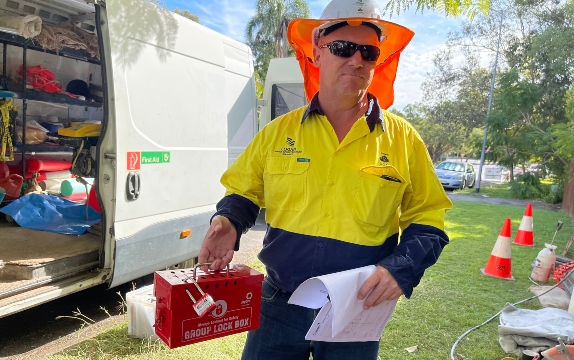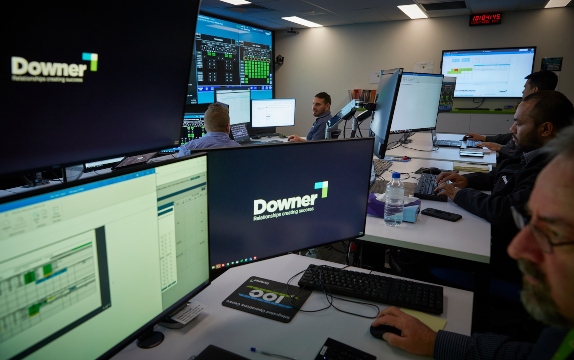Our approach
Safety is the first of Downer’s four Pillars. Zero Harm is embedded in our DNA.
Our steadfast commitment to the safety of our people is validated in responses to employee engagement surveys, materiality assessment surveys, and the performance benchmarking we undertake every year.
Downer has consistently achieved strong health and safety results, including in sectors that are exposed to high-risk activities. We are proud of our safety performance, and we also understand that we face challenges to maintain and improve this record, and continuously engage with our people to safeguard against complacency in the workforce.
Our commitment to the health and safety of our people and our communities is expressed in strong safety leadership, engagement with our workforce and stakeholders, and a continual focus on identifying and managing risks.
This commitment is reflected in the results we have achieved and our increased presence as Zero Harm thought leaders. Downer’s health and safety commitments are outlined in our Health and Safety Policy, which can be found here.
Our performance
The performance information in this section includes Downer Australia and New Zealand operations. The performance data also includes Downer contractors and Downer employees involved in unincorporated joint ventures.
To achieve Downer’s targets and objectives relating to Health and safety, Downer prioritised the following short-term focus areas in FY22, which we committed to in our 2021 Sustainability Report:
Focus area |
Result |
|
Reference |
|---|---|---|---|
|
Continue the consolidation of Critical Risk bow tie analysis and verification through our Communities of Practice |
✓ |
|
|
|
Implement the improvements and outcomes identified by the Communities of Practice and incorporate them into The Downer Standard |
✓ |
|
|
|
Build on the progress made on The Downer Standard and extend our consistent approach into deeper layers within the company, improving utilisation by the frontline |
✓ |
|
|
|
Enrich the quality of our data and utilise emerging technologies in our strategy and planning activities |
✓ |
|
|
|
Roll out Downer’s Enterprise Data Warehouse (EDW) to provide a robust foundation for advanced data analytics and reporting, including the introduction of data science techniques such as natural language processing and other forms of machine learning |
✓ |
|
|
| Refine our in-house training programs to reflect The Downer Standard, and increase the risk management competency of our workforce | ✓ | Progress on The Downer Standard | |
| Continue to monitor all COVID-19 risks and controls and support Government vaccination roll-out strategies. | ✓ | COVID-19 response |
Downer Group safety performance
Downer’s Total Recordable Injury Frequency Rate (TRIFR) for FY22 was below target at 2.35 which was an improvement on 2.60 in FY21. Downer’s Lost Time Injury Frequency Rate (LTIFR) was also below target at 0.82, which is an improvement on the FY21 result of 0.99. This is below industry benchmarks published by Safe Work Australia for all industries which Downer operates in, the lowest of which relates to Architectural, Engineering and Technical Services with an LTIFR benchmark of 1. See table below for 12-month rolling frequency rates.
Sadly, a long-term Downer employee in New Zealand died in May 2022 following a fall at work. Although the cause of death is not yet known, Downer has treated this as a workplace fatality. This incident is a reminder of the challenges of ensuring we remain vigilant and relentlessly manage the Critical Risks associated with the work we do every day.
Communities of Practice
This year, Downer’s Communities of Practice commenced a multi-year program of work to deliver the optimisation and consolidation of the Critical Risk program. Delivering this work through a Community of Practice forum enabled us to harness the expertise of our people and operational requirements.
Downer currently has 10 active Zero Harm Communities of Practice, with a number of sub-groups to focus on activities that occur relevant to the risk. For example, the Health and Hygiene Community of Practice has sub-groups associated with specific risks within that subject area, such as noise and health monitoring to support the different risks and requirements associated with the work. Each Community of Practice consists of Operational and Zero Harm employees from across the Group, and is sponsored by a Downer Executive.
The scope of works for these communities involves consolidation of Critical Risk activities, and the Critical Controls associated with the activity, to reduce duplication, drive consistency in how risks are managed and how work is performed, and drive improvements in data collection and analysis.
This consistency streamlines our management of Critical Risks across the Group, and will ultimately make it easier for our people to make the right safety decisions. The outcomes of the work are embedded into our systems and processes, and the information is provided to frontline employees – making it easier for them to understand what Critical Risks are present and which Critical Controls must be present, or may be optional, depending on the nature of the work.
The results of this work will be considered when reviewing training systems and programs, to provide our workforce with accurate information concerning the management of risks.
During FY22, the Communities of Practice completed a comprehensive review of the respective Critical Controls applicable to their areas. This included:
- Developing a master Critical Control library, along with Critical Control function description to support frontline employees in making sure that the right controls are selected
- Finalising bow tie consolidation
- Establishing the Cranes and Lifting Community of Practice, and Scaffolding Community of Practice, which have continued to improve information in The Downer Standard, which is accessible across the organisation. These enhancements have been informed by feedback from the frontline, and have driven best practice and consistency of approach and understanding of the risks. These communities also review industry guidance data and incidents to assess the impact on our systems of work for these activities, and drive any required changes.
A number of Communities of Practice have also prepared training and information to support the work they have completed, and started the process of reviewing our systems and processes on The Downer Standard.
Reinforcing The Downer Standard
In FY22, Downer built on the foundations established through The Downer Standard, and the benefits provided by centralised information, requirements and processes. We have focused on responding to feedback to enhance the clarity of the information provided, reduce duplication and capture opportunities to improve the way we work, and the information we collect.
The feedback received through The Downer Standard not only offers positive opportunities for improvement, it also demonstrates that the system is being effectively utilised by the business.
We conducted a Group-wide review of the Safety Management Plan template and model content, working across the organisation to modernise our approach to responding to the various requirements of the different types of work we typically undertake, and capture regular customer requirements. This work has also led to the development of additional model safety management plans that are specific to customers we work with most frequently, and to better reflect the breadth and diversity of our services. This work would have been significantly harder to achieve without having a centralised approach in place.
Our future focus
In FY23, Downer will renew our focus on progressing key strategic health and safety programs and initiatives. These future areas of focus include:
- Continuing to build the integrity of our consolidated Critical Control library gap analysis to verify inclusion of regulatory requirements accompanied by compliance mapping
- Conducting gap analysis review of Safe Work Method Statement controls and aligning with the Critical Risk Control library
- Conducting review and gap analysis of inspection and audit forms with the Critical Risk control library for consistency, optimisation and to eliminate duplication
- Continuing to analyse incident data, optimised with artificial intelligence tools to provide valuable insights regarding Critical Control effectiveness and incident causal pathways
- Continuing to improve the quality and effectiveness of information to frontline employees, through bespoke training programs providing concise targeted information concerning the core ‘go/no go’ Critical Risk controls for relevant Critical Risk activities
- Reviewing permitting processes to drive alignment and effectiveness of subcontractor management
- Reviewing and refining lessons learned processes to increase effectiveness and enhance the quality of the information obtained through the process, which improves Critical Risk and control analysis, causal pathway understanding and systems of work
- Reviewing and improving Zero Harm management system content, integrating outputs of Communities of Practice and insights from the Critical Risk program.
Emerging issues and market trends
Managing public aggression
Providing a safe workplace is a fundamental principle of health and safety and human rights.
Violence and aggressive behaviour by members of the public towards employees who interact with the public, or conduct work in public locations, is increasing in our workplaces, mirroring increasing rates in society in general.
Protecting our people from exposure to this risk requires a new way to look at protection and providing workplace safety. To better understand the impact of violence and aggression in our workplaces, Downer has established a Community of Practice to explore the ways in which violence occurs, and to develop a best practice framework to support our people in the management of this risk.
Transformative technology
Technology is changing the work that we do – and the way we do it. We recognise that this can deliver considerable improvements in the productivity and safety of our workforce, but we must remain aware of the potential issues when rolling out technology. Opportunities include the ability to reduce manual, repetitive, high risk tasks. The reduction in human exposure to these tasks decreases the possibility of significant injury across the workforce. Throughput may also be increased with the deployment of technology, allowing expansion of productive activities.
The roll-out of technologies is not without risks. The risk of digitalised psychosocial violence is prevalent when technology is rolled out without consultation. Employees may fear job losses if a number of previously manual roles are replaced by technology. A loss of autonomy and privacy may result when workers are forced, in rapid fashion, to reskill and upskill without a considered transition plan and consideration of the skills and experiences of employees.
Trust is another issue. When rolling out technology, we may not harness its full potential because we don’t trust it to replace humans to do particular tasks safely, or we may not believe it can do tasks as well as humans can. Conversely, we may over-trust technology and not implement sufficient monitoring parameters and procedures, and this can result in adverse outcomes from a health and safety perspective.
An increasing trend with the roll-out of new technology is workers spending more time using screens, monitoring processes rather than completing them manually. This results in increased time sitting or in sedentary positions. Downer utilises ergonomic workplace equipment, encourages agile office environments, and provides our workforce with information on the risks associated with sitting for prolonged periods of time. For operational staff, we utilise practices such as task rotation to safeguard against overuse and underuse risks.
Downer has been exploring the increased use of automation and robotic equipment. Further, drone technology has been deployed to monitor risks at locations where a top down view can provide enhanced visibility over on-the-ground monitoring.
Downer collaborates with technology experts to explore opportunities for new and enhanced technology. In doing so, we ensure that technology is rolled out with significant consultation with all stakeholders to ensure that multiple perspectives are considered.


